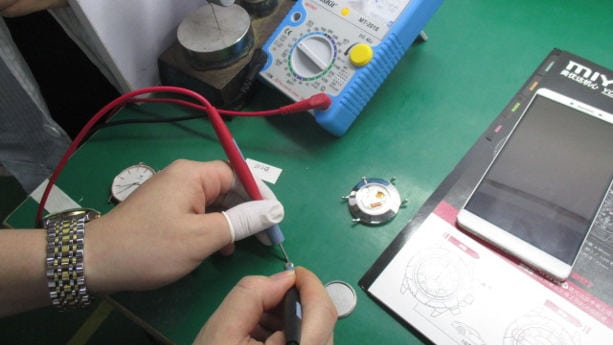Suggestion: Watch the 10 minutes video tutorial before reading this article
Once your products are paid for in full and shipped, you’re beyond the point of no return. If you were to find quality issues once the goods arrive in your country, it’s game over.
Forget about getting a refund or returning goods to your supplier.
Instead, you need to be sure that your products are matching all technical specifications and quality requirements before you pay the balance.
In this article, I answer the most common questions about the practical aspects of ordering a quality inspections in China.
Keep reading, and learn how much you should pay for an inspection, how to book one online – and why you should not let your supplier do the inspection by themselves.

Why do I need quality inspections when importing from China?
Manufacturing is not an exact science. The question is not if, but how severe the quality issues are.
I have inspected hundreds of orders in person, and this is what I often found:
- Scratches
- Dirt
- Marks
- Minor cosmetic issues
This is even to be expected. However, there are also more severe quality issues:
- Loose parts
- Incorrect labels
- Incorrect design
- Incorrect colors
- Damages
Quality issues are, in a way, as certain as death and taxes. This is not unique to China, but the case when manufacturing in any country.
However, what is unique to China, and most other countries in Asia, is that you cannot return goods if you find quality issues in your own country.
For this reason, quality inspections are a crucial step of the process. You simply cannot skip this part of the process.

FREE CONSULTATION SESSION
- 1. How to create product designs & specifications
- 2. Finding suppliers in China, Vietnam & India
- 3. Shipping & import taxes (US, EU, UK & Australia)
- All attendees can ask questions!
- Best Regards, Ivan Malloci
What kind of checks can the quality inspector do?
Anything that can be done with the available equipment. A few examples follow below:
- Take photos of product and labels
- Dimensions and measurements
- Visual inspection (look for damages and defects)
- Function tests
- Label check
- Drop tests
- Water pressure tests
- Packaging
The goal is to verify that the product is matching all specifications and quality requirements.
What do I get after the quality inspection?
Within one working day after the quality inspection is executed, the agency will send you a PDF report with photos and other data they collected.
For example, they may include dimensions, defect descriptions, the number of defects found and more.
You can also request videos.
Keep in mind that the PDF report corresponds to the quality checklist, so you get what you ask for. They will not improvise during the inspection.
What will I do with the quality control report?
The report shows the number of defects, together with images and descriptions. Hence, the report can help you decide if you approve or reject the order.
Keep in mind that you should set an accepted defect rate before you place the order. Otherwise it’s hard to say if the number of defects is acceptable or not.
How do I know if my supplier accepts a quality control?
Firstly, you should never even a consider a supplier that is not fully accepting a quality inspection.
The suppliers that do reject, or even hesitate to accept, a quality inspection always (and I mean always) have something to hide.
Such suppliers intend to scam you, or subcontract your order to a local sweatshop.
Should I let my supplier know in advance?
Yes, you should inform your supplier that you intend to get the order quality control as early as possible. Even before you have placed a sample order.
It’s crucial to make the supplier understand that you are a buyer with a serious quality assurance process in place.
Not one of those gullible buyers who bend backwards to accommodate the supplier.
Trust me when I say that Chinese suppliers have absolutely no respect for buyers who give in easily to their demands.
They like to test their customers by throwing out the most absurd demands, such as suggesting that a quality inspection is not even necessary.
Don’t fall for this trick.
How do I book a quality control online?
These days, most established quality control agencies have online booking systems. All you need to do is to login and submit the following information:
- Supplier name
- Contact details
- Factory address (if any)
- Product specifications
- Quantity
- Checklist
- Inspection date
At Chinaimportal.com, we cooperate with Sofeast.com, based in Hong Kong and Shenzhen. Our customers can access the Sofeast booking system directly via our Dashboard.
How much time in advance should I book the quality control?
Most QC companies advertise that they accept bookings made only 72 hours before the date. That said, this assumes that you already have a quality checklist. If you need advice from the QC company on how to outline the checklist first, you should book at least 3 weeks in advance. The earlier the better.
How much should I expect to pay?
Most established agencies, including Sofeast.com, charge around US$300 per inspection. This also includes travel expenses.
However, some agents charge as little as US$150 to 200 per inspection. Then again, you get what you pay for.
When should the products be inspected?
At a minimum, you should get the products inspected before the shipment and balance payment. However, you may also want to consider an on-site quality inspection during production.
A quality inspection that takes during production can help you find early stage quality issues (i.e., incorrect colors or materials), and correct them while there’s still time.
If your order volume is above US$10,000, I would strongly suggest that you do both during production and pre-shipment inspections.
How do I know what kind of checks the inspector should do?
The point of the inspection is to show you the state of your products. You can ask them to report anything that can be obtained while in the factory.
For example, you want product photos, dimensions, a packaging check and a visual inspection.
The Inspection agent will do the checks you instruct him or her to do, so don’t leave anything out. Keep in mind that you are the product expert here.
Further, you should also instruct the agent to take a closer look at potential quality issues found during the sampling process.
How do I know that the inspector is qualified to check my products?
Most established agencies are qualified to inspect basically any product. Ultimately, it comes down to what you write in the quality control checklist.
There are few, if any, inspection agencies that specialise in certain product categories.
What matter is that they have a solid track record, and that you provide a clear and measureable checklist.
Do I need to send pre-production samples to the agent?
You don’t have to, but it can help the agency to better understand the product. That said, most of our customers don’t send samples prior to production.
Reference samples can be very helpful when checking fabrics and other materials during an inspection, as it’s otherwise hard to confirm if the product is correct.
Will the inspected samples be destroyed?
Not in most cases, but some quality tests may damage the product to some extend. This includes fire retardant, material weight checks and water pressure testing.
That said, you only need to use one unit for most such tests.
Can I go to China and do the inspection on my own?
Sure, you can fly to China and visit the factory by yourself. In fact, this is something I encourage you to do, before you place your first order.
However, when it comes to quality control, you will not only save money on hotels, flights and visas – but also find that the quality inspector does a better job than you yourself would.
There are of course exceptions, but a professional inspector will almost always do a better job at finding defects than a novice buyer.
Should I do quality control on every order?
Yes, you should get every single order inspected.
As said, manufacturing is not a science, and one faulty or damaged component can ruin the entire batch.
Given that one defective batch can ruin your reputation, or even get your Amazon account suspended, you must always check quality before shipment.
Further, your supplier is much more likely to keep defects to a minimum if they know that you will get the batch inspected.
If you start relaxing, so will they.
Can the quality inspection company also check if the products are compliant with mandatory safety standards?
The agent can check labels, and verify compliance with mechanical (i.e., loose parts or sharp edges) compliance requirements.
However, they don’t have the equipment to do more complex product safety testing (i.e., electrical or EMC testing), or chemical and heavy metals checks.
While portable testing equipment will be available in only a few years time, further expanding the role of quality inspection companies, that is not yet the case.
For such tests, the agent can collect batch samples for submission to an accredited compliance testing company, such as SGS or Asiainspection.
Keep in mind that the lab test is paid separately, and is often more expensive than the quality check.
What happens if they find quality issues?
Most likely, you will find quality issues. If the inspector only finds a few minor quality issues, you can go ahead and approve the order.
If the issues are more severe, you should require your supplier to remake or repair the products – and then get the order inspected again.
Keep in mind that you will need to deal directly with the supplier. The agent will not negotiate compensation or anything like that with the supplier.
Can’t I just do a quality inspection when the goods arrive in my country?
Sure you can, but what’s the point?
Assuming you find quality issues, there is nothing you can do. You cannot return products to the supplier, or force them to refund you.
And even if they are willing to accept a return, it’s hard to get the products through the Chinese customs.
Refunds are complicated too, due to capital controls.
But most likely you will not need to deal with either the customs or capital control, as the supplier can simply deny any compensation and walk away.
Most quality issues are caused by misunderstandings or vague spec sheets. No supplier will lose profit, equivalent of 20 orders, simply because the products don’t confirm the buyers perceived (and even imaginary) idea of ‘good quality’.
Why can’t I let the supplier do the quality inspection?
Well, you should expect that they have some sort of quality management system in place, but you cannot expect that the supplier will be impartial and give you an honest quality report – in case they would find quality issues.
Instead, you need a trustworthy third party, with a solid track record in the quality assurance industry, to give you a report that shows the actual state of your products.
Some suppliers do claim that no third party inspection is needed, because they will check the products themselves.
And some buyer’s swallow that, and get the result they deserve.
What if quality issues occur weeks or months after I’ve started selling the product?
Post-sales quality issues are very tricky, as they may be hard to detect during the quality inspections.
Such quality issues include, for example, the following:
- Faulty electronics components
- Glued components falling off
The key is to find ways to simulate product usage, and stress test the product.
For example, if you’re shipping the product Europe or North America, you can try to see how the product reacts to below zero temperatures.
























I have been living in China since 2013.
I provide services for checking the quality of goods before shipment.
· I have a technical education in the automotive industry.
· I can read engineering drawings.
· I have the skills to use a hand-held measuring tool.
· I know the principles and standards in the field of quality control.
· I have a residence permit, my own company is registered in China.
· Have Chinese driver’s license and Xpeng G3 personal car.
Hi Fredrik,
Are you looking for partner in Thailand , Please do not hesitate tocontact me .
The facts that have been addressed here are very critical. Thank you so much for sharing a great post. learned a lot about quality control.
A very detail guideline almost included all the questions about quality control inspections.
One of the most important is that customers need to deal directly with suppliers to ensure that the factory will remake or repair defective products. But in many cases, customers just want to pay less, and then the QC agent guarantees 100% of the product quality because they don’t want to encounter negative reviews from selling, This will actually cause a lot of risks Because everyone knows that the quality of the product cannot be just controlled individually at the end of production, which involves the supply chain, so find suppliers with a complete quality control system or an excellent supply chain to control the quality of the product will be also important
A Good article which is worth reading it . Thanks for sharing the information
Hey Fredrik,
Nice article!
I was wondering, do you offer QC and help with people seeking to import research chemicals/liquids/pharmaceuticals ?
Hi Dennis,
No, unfortunately, we don’t have a partner for chemicals and pharmaceuticals QC
Hi my name is Derrik Vassar, and i was wondering if you can set-up a QC inspection for the goods that i have made ordered? Please email me. Thank you.
Hello Jonathan, we can help you with QC inspections if you are interested. would you mind to send us email at info @ aqiservice.com? Thanks
good info.Thanks
Hi thanks for the great work. I’m looking forward to importing a semi knocked down of led bulb, and do the assembly myself. Do things like this require quality control inspection?
Thanks in anticipation
Hi Abba,
Quality inspections are essential regardless of what you import. You cannot return defective or damaged products.
Good article.Thanks
Nice topic, Thanks for sharing.
Nice overview!
A few comments that went through my head as I read this article:
– Incorrect design is something that might be detected during an inspection, but really it should be detected on pre-production samples.
– I fully agree on not working with suppliers that don’t accept an inspection. Having said that, some buyers frighten their suppliers by writing “we will appoint a third-party inspection agency to come and check the goods”. There is no such thing as a third-party inspection agency (for audits yes, for inspections no), anyway. Better to say “an inspection agency will contact you to schedule QC inspection(s)”.
– If you place very small orders, on which the factory makes close to no margin, it is not necessarily a red flag if they say no to inspections.
– The checklist is the fundamental document the inspector(s) will work on. You are absolutely correct. But don’t ask the inspector to confirm that the body of the product is made of 302 steel and the feet are made of RSS-2 rubber… Confirming this in the factory is not easy. The only way is often to check the purchasing paperwork but it can be faked easily.
– For buyers of simple consumer goods, the most common mistake I see is not defining what is a major defect, what is a minor defect, and what is imperfect but acceptable. If they did this with photos and got the factory people to sign off on it, they would have a good chance of realizing that that factory simply can’t comply with their standard.
Thank you for the feedback Renaud. I completely agree!